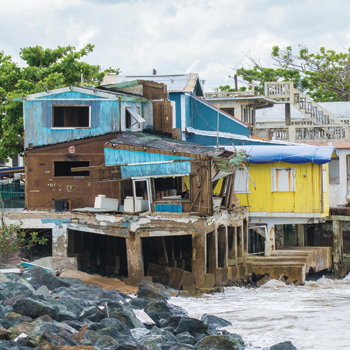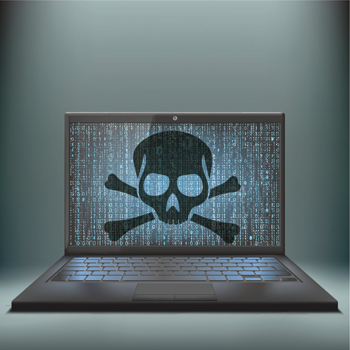Update on medicine in post-hurricane Puerto Rico
ACP's Governor for its Puerto Rico chapter describes his experiences during Hurricane Maria, the ongoing challenges facing the island, and the College's efforts to help the island's medical community.
It had been over a month since Hurricane Maria struck when José Lozada, MD, FACP, ACP Governor for Puerto Rico and a hematologist/oncologist, spoke to ACP Internist. But medical practice and everyday life in Puerto Rico were still far from normal. Dr. Lozada described his own experiences during the hurricane, the ongoing challenges facing the island, and potential assistance from the mainland in a phone interview in early November.
Q: What was it like during and immediately after the hurricane?
A: This hurricane officially hit us as a category 4 storm, but with the gusts it was pretty much category 5, and it was a slow track through the island, so it was over 12 hours. The impressive part was going outside after. The main issue—that is still giving us trouble—is our very outdated power grid was just completely obliterated. This thing snapped cement poles like they were matchsticks. The big towers that carry power transmission cables, a lot of those were bent or knocked down. We lost telecommunication. Cell service was basically nonexistent. Few people have old-style phone lines anymore. People either go with cell phones or with cable, and cable companies need power.
Q: How did the loss of power affect hospitals?
A: The first couple of weeks were very tough. Hospitals were running on diesel plants. Right now, out of 65 working hospitals on the island, 57 have electricity. The ones we had at the beginning were all running on diesel plants, and it was hard to get diesel to keep them running. The first week or two, [there were] 12-hour lines at gas stations.

Hospitals that were on the grid, they would lose power … surgeons having to use the flashlight on their cell phone because they lost power in the OR. Because of lack of refrigeration, access to insulin was an early problem, although that's been fixed. People were having problems just getting to the hospital, because the roads were blocked, they couldn't contact an ambulance.
In the hospitals at first, we had problems with blood products, because no flights were coming in for several days. We have backup with the American Red Cross and some private blood banks that have contracts with some blood banks in Florida, but if there's no planes coming in … I remember in the onc ward, because of chemotherapy and other problems, there were like 12 patients with very low platelets and we had none for several days. We'd joke with the nurses, “Just don't drop them, please. Don't let them hit their heads, because we'll be in trouble.”
Q: How are things now?
A: Now the patients are pretty much able to get to the hospitals and hospitals are working. We have 65 working hospitals, which is most of them. But the outpatient care continues to be a big challenge, particularly for the internists. The main issue is power. Right now, if you look at the government site, they say we have 33% power generation, but that's the capacity of generating power. That doesn't mean that 33% of people and businesses have power. That's much lower. That's under 20%.
My wife is saying, ‘I miss the air-conditioning,’ but I get home, we light up a gas lantern like you'd use for camping, and then I light up the charcoal grill and we barbeque every night. That's a minor issue, not having power at home, compared to not having power at the offices.
Puerto Rico is always a decade or two behind the states in business models of medicine. Down here, the concept of a full-time hospitalist has never really taken off. Most internists have solo practices, or maybe one associate, and they do fee-for-service work or are capitated.
Most offices don't have power. It depends on where doctors have their offices how bad the situation is. If you have an office in an office building, like I do, [with] its own emergency power plant, between the 40 offices here, we split the cost of diesel. Maybe a month of diesel for the plant to run on limited hours is going to be about the same as I pay for electricity.
Remember our censuses are all down, because the patients have no phone, maybe no transportation. Sometimes the offices have no phone. You don't know how many patients you're going to get. Even paying what you usually pay [for electricity] is a problem.
But here a lot of doctors buy old houses and turn them into an office, so they are solo in their structure, so they have to have their own small generator, either diesel-run or gasoline-run. If you have a diesel generator and you're opening like maybe 8 [am] to 2 [pm], [you] can spend $100 to $200 a day on diesel. And if you're seeing five or six patients a day, some are saying, ‘It's not worth it for me to open the office.’
Maybe they'll open two hours a day, some of them sitting on the sidewalk, because it's 86, 88 degrees down here. The patients will come before it gets too hot and get their prescriptions. That's a significant burden, but relatively few [physicians] have left. Most of them are trying to keep working, keep doing their hospital rounds, seeing the patients that they can.
Q: Has the shortage of outpatient care put a strain on hospitals?
A: More patients are going to hospitals. So far there are a couple of measures that have eased that, for example, so far patients can show up to the drugstores with their pill bottles and even if they have no more refills, the drugstores are refilling them for 30 days until they can go to their doctor. The drugstores opened up pretty early even without power. Another thing is because of HHS rules—[and] the Medicare Advantage plans and most of the private health plans have followed suit—during this time they are not requiring preauthorizations for medications and X-rays.
Q: What are the prospects for things getting back to normal?
A: That's the tough part, right? A month ago, we had 15% generation, so in a month that's doubled, but nobody gives us a timetable. The governor set an aggressive timetable, but the fact that he is asking that of the power authority doesn't mean that they can deliver. He says, ‘I want 95% of people to have power by Dec. 15.’ There's no firm schedule of when what areas are going to be illuminated. So that's the biggest challenge—power.
It's a big domino effect, because if you don't have power, most small businesses can't run, so people don't have jobs. If you have physicians who have two or three employees but [are] seeing five patients a day, you have nurses and secretaries who are laid off until the power comes back.
Q: What kind of assistance have you gotten from medicine on the mainland?
A: The ACP—Dr. [Jack] Ende and his staff—wrote this amazing letter to the [federal] government. My class of Governors has helped a lot, [as did] the different medical societies. ACP has 152,000 members, and the show of support down here has been fantastic and we really appreciate it.
A lot of medical volunteers have come down here. But we don't need the manpower. We have the docs. A lot of our docs use their time off to do volunteer work, which is fantastic. We have the hospitals, we have the medications. The drug distributors, the drugstores are working—all of them with power plants. But until the power issue is solved, returning to normal is impossible.
Q: Is there anything physicians on the mainland can do to help?
A: The main help would be … we have a lot of families where part of the family is here, part of the family is on the mainland. A lot of the people whose parents were here, as soon as they could, they bought them a ticket and shipped them [to the mainland] only to find out that most of them don't have Medicare Part B. Most of them get a Medicare Advantage plan down here, because the copay is lower. The problem with Medicare Advantage is that it doesn't cross state lines. They are cheaper, but they only cross state lines for emergencies.
One piece of help is that if patients from here don't have a health plan, have consideration—not necessarily charity, but whatever [internists] can do to help these patients while they're up there would be appreciated. They're eventually going to come back when things normalize. I don't think we're going to have a mass permanent exodus. I think that's the best thing they can do for us—to keep our people healthy while we normalize down here.



